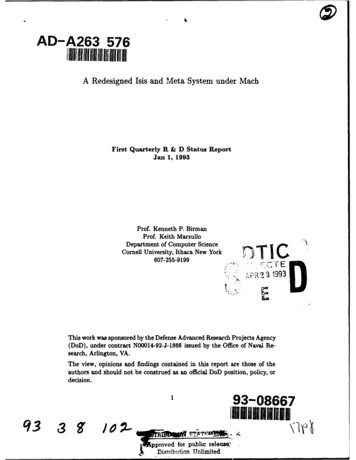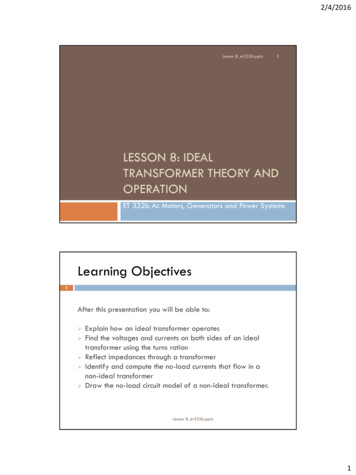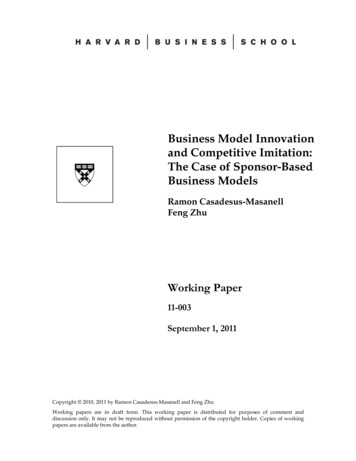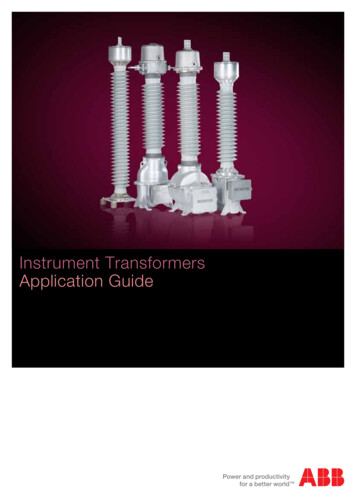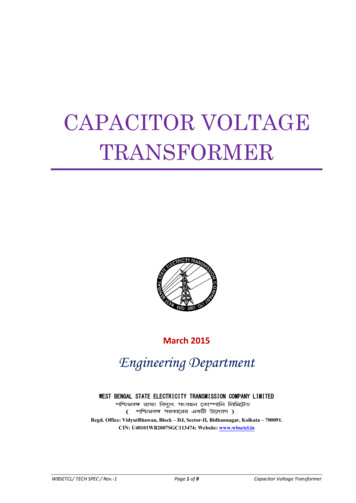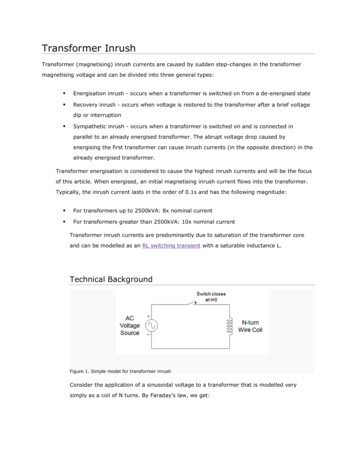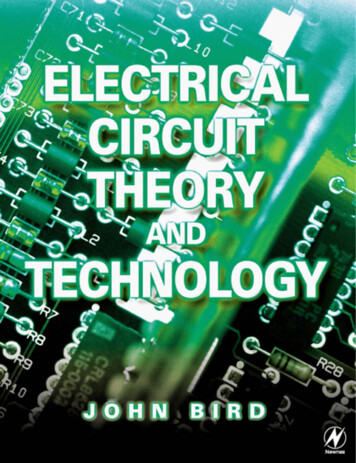
Transcription
Transformer-based Meta-Imitation Learning forRobotic ManipulationThéo Cachet, Julien Perez and Seungsu on learning has been considered as one of the promising approaches toenable a robot to acquire competencies. Recently, one-shot imitation learning hasshown encouraging results for executing variations of initial conditions of a giventask without requiring task-specific engineering. However, it remains inefficient forgeneralizing in variations of tasks involving different reward or transition functions.In this work, we aim at improving the generalization ability of demonstration basedlearning to unseen tasks that are significantly different from the training tasks. First,we introduce the use of transformer-based sequence-to-sequence policy networkstrained from limited sets of demonstrations. Then, we propose to meta-train ourmodel from a set of training demonstrations by leveraging optimization-basedmeta-learning. Finally, we evaluate our approach and report encouraging resultsusing the recently proposed framework Meta-World which is composed of a largeset of robotic manipulation tasks organized in various categories.1IntroductionAs robotic platforms are becoming affordable, end-user environments like personal houses arebecoming a novel context of deployment for such systems [7]. However, the robotic manipulationplatform has traditionally been deployed in a fully specified environment with predefined and fixedtasks to accomplish [6]. For this reason, we need to develop control paradigms where non-expertusers will be able to specify new tasks, possibly complex and compositional. Recently, reinforcementlearning has attracted a lot of interest to tackle this problem [8, 5]. Nonetheless, safe and efficientexploration in a real environment can be difficult [4, 1] and a reward function can be challenging toset up in a real physical environment. As an alternative, a collection of demonstrations have oftenbeen proposed as a convenient way to define a new task [13, 10].In this paper, we propose an approach that associates metric-based and optimization-based metalearning to perform transfer across robotic manipulation tasks beyond the variation of the sametask using a limited amount of demonstrations. First, we introduce a transformer-based model ofimitation learning. Second, we propose to leverage optimization-based meta-learning to meta-trainour few-shot meta-imitation learning model. This approach allows us to efficiently use a small numberof demonstrations while fine-tuning the model to the target task. Finally, we evaluate our approach tothe recently proposed framework Meta-World [15] that regroups a large set of manipulation taskswhich are organized in several categories. We show significant improvement compared to the oneshot-imitation framework in various settings. As an example, our approach can acquire 100% successon 100 occurences of a completely new manipulation tasks with less than 15 demonstrations.2PreliminariesThe goal of imitation learning [11] is to train a policy π that can imitate the expert behavior expressedin the demonstrations. In this context, one-shot imitation learning setting [2, 3] aims at learningNeurIPS 2019 Workshop on Robot Learning: Control and Interaction in the Real World, Vancouver, Canada
a meta-policy that can adapt to new, unseen tasks from a limited amount of demonstrations. Theapproach has originally been proposed to learn from a single trajectory of the target task. However,this setting can be extended to few-shot if several demonstrations of the target task are available. Here,we assume an unknown distribution of tasks p(τ ) and a set of meta-training tasks {τi } sampled fromit. Then, for each meta-training task τi , a set of demonstrations Di di1 , di2 , .diN is available.Each demonstration d is a temporal sequence of { observations ; actions } tuples of successfulbehavior for that task dn [(on1 , an1 ) , · · · , (onT , anT )]. This meta-training demonstration can havebeen produced by human or heuristic policies if tasks are simple enough. In a simulated environment,it is even possible to use reinforcement learning to create a policy from which trajectories can besampled. Then, each task can contain different objects and require different skills from the policy. Inthe case of robotic manipulation tasks, these tasks can be for example Reaching, Pushing, Sliding,Grasping, or Placing. Each task will be defined by a unique combination of required skills and thenature and positions of objects define a task.Overall, one-shot imitation learning techniques learn a meta-policy πθ , which takes as input boththe current observation ot and a demonstration d corresponding to the task to be performed, andoutputs an action. Conditioning on different demos can lead to different tasks being performed forthe same observation. At training time, the algorithm first sample a task τi , and then sample twodemonstrations dm and dn corresponding to this task. The meta-policy is conditioned on one of thesetwo demonstrations dn and optimize the following loss on the expert observation-action pairs fromPTmthe other demonstration, dm : Lbc (θ, dm , dn ) t 1 L(amt , πθ (ot , dn )) where the L is an action2estimation loss function; in this paper we simply use L norm for this.The one-shot imitation learning loss consists in summing across all tasks and all possible correspondPM Ping demonstration pairs: Losi (θ, {Di }) i 1dm ,dn Di Lbc (θ, dm , dn ), where M is the totalnumber of training tasks.3Transformer-based Meta-ImitationFirst, we propose to improve the policy network of [2] by using a transformer-based neural architecture [14]. This model allows to better capture correspondences between the input demonstrationand the current episode demonstrations using the multi-headed attention layers introduced in thetransformer architecture. To adapt this model to demonstration-based learning, the encoder takes asinput the demonstration of the task to accomplish and the decoder takes as input all the observationsof the current test episode. So, we add a mixture of sinusoïdes with different periods and phases toeach dimension of the input sequences to encoder positioning informations. As in one-shot imitationmodel, the next action to perform is the output of the model. Second, we propose to leverageoptimization-based meta-learning [9] to pre-train our policy network. Algorithm 1 describes thethree consecutive steps of our meta-learning and finetuning algorithm. First, our policy is meta-trainedusing Reptile over the set of training tasks with an early-stopping over validation tasks. Finally, wetest the model by fine-tuning on the corresponding demonstrations. In this last step, the fine-tunedpolicy is evaluated in terms of accumulated reward and success rate by simulated episodes in theMeta-World environment.4ExperimentsEvaluation framework: All the evaluations are done in the Meta-World framework [15] which iscomposed of 50 manipulation tasks. To sample our demonstrations, we train a neural network policyfor each task using clipped Proximal Policy Optimization [12]. The network used for RL-trainedpolicy is a stack of fully connected layers as policy with the current state as input and action as output.Following the results reported in [15], we manage to converge a successful policy for a total of 46out of 50 tasks with the same hyperparameters. This success signal provided by the framework allowsus to evaluate our meta-train policies. We gather 5K demonstrations per task for meta-training bysampling the PPO-trained policies. Then, The user tasks are defined using demonstrations as we donot assume having access to a reward signal or having the possibility to explore the environmentat test-time. Using the shape of the task reward function, we group each task of Meta-World in 3categories which are (1) Push (2) Reach and (3) Pick-Place as defined in [15].2
Algorithm 1 Meta-Learning and Testing algorithm with ReptileInput Set of demonstrations DTr , DTe , DTs of train, validation and test tasks TrInput Meta learning rate β1: Initialize policy πθ2: while not Earlystop do3:for all task τ in Tr do4:Sample batchs of pairs of demonstrations {dτi , dτj } from DTr (τ )5:Compute Wi Adam(Lbc (τ, πθ ))6:Update policy: θ θ β(Wi θ)7:end for8:ValLoss 09:for all task τ in Te do10:Sample all pairs of demonstrations {dτi , dτj } from DTe (τ )11:Compute θ0 Adam(Lbc (τ, πθ ))12:V alLoss Lbc (τ, πθ0 )13:end for14:Earlystop(ValLoss)15: end while16: for all task τ in Ts do17:Sample all pairs of demonstrations {dτi , dτj } from DTs (τ )18:Compute θ00 Adam(Lbc (τ, πθ ))19:Execute πθ00 on simulator for N episodes20:Mesure reward, success rate21: end for. Meta-Train. Validation. TestArchitecture: we compare the performance of our Transformer architecture to the state-of-the-artrecurrent architecture. Both models are meta-train using Reptile and individually fine-tuned on eachtest task. We note a dramatic improvement for transfer across tasks, the results are summarizedin Figure 1. We believe this result is particularly valuable as Pick-Place tasks are known to bechallenging and usually require a large number of trials in a reinforcement learning setting as reportedin [15]. In the case of transfer within the same task category, the comparable performances confirmthe successful results reported in [2]. Nonetheless, in this setting, our Transformer-based policyseems to better handle the case with the lowest amount of demonstrations. For transfer across taskcategories, our model shows clear superiority which can be explained at least in two ways.Meta-learning and Finetuning: We compare all considered pre-training approaches and we focuson the proposed Transformer-based policy. Results are depicted in Figure 2. As a first baseline, weconsider the case where no pre-training strategy is applied. We use Xavier uniform initializationthen directly optimize the policy on the demonstration of the test tasks. Otherwise, we pre-train apolicy with Reptile or with Multi-Task which is mixing all tasks in the batch gradient. The fact thatrandom initialization is inferior assesses the complexity of the considered tasks and confirms that themeta-training approaches do capture regularities of the consider environment across tasks. In transferwithin the same task category, Reptile seems to provide better results as the number of demonstrationdecreases as for transfer across different task categories. Finally, we evaluate the performance of theMulti-task approach without performing finetuning. This training approach is the closest to the oneproposed in the one-shot imitation method. The model does capture regularities that allow it to havea success rate in transfers within task categories.3
windohamm soc w op allrt v er v cer v en v tasks1111OSI ReptileTransformer Reptiled inhanrn l tudiav1to ineeppe pegg in unbabopsse w ert s lug s ket x clo allbaididsall v1 e v1 e v1 ll v1 e v1 tasks1laclack p1.0lac0.8pic0.40.6success 10 shots0.0k p0.20.00.20.40.6success 15 shots0.81.0OSI ReptileTransformer Reptile0.2pic0.01.0e vk placpic1.0k p0.8OSI ReptileTransformer Reptile0.8OSI ReptileTransformer Reptilepic0.40.6success 10 shots0.40.6success 15 shotspe pegg in unbabopsse w ert s lug s ket x clo allbaididsall v1 e v1 e v1 ll v1 e v1 tasks10.20.2e v0.00.0sw1.0v1sewindohamm soc w op allrt v er v cer v en v tasks1111v1hanl tudiav1to ineepswpe pegg in unbabopsse w ert s lug s ket x clo allbaididsall v1 e v1 e v1 ll v1 e v1 tasks1laclac0.8k p0.6lac0.4success 5 shotspic0.20.8e vk placpick p1.0piclack plack ppic0.80.40.6success 10 shotsOSI ReptileTransformer Reptilepic0.40.6success 5 shotsOSI ReptileTransformer Reptile0.00.2pe pegg in unbabopsse w ert s lug s ket x clo allbaididsall v1 e v1 e v1 ll v1 e v1 tasks10.2OSI ReptileTransformer Reptile0.0e vpe pegg in unbabopsse w ert s lug s ket x clo allbaididsall v1 e v1 e v1 ll v1 e v1 tasks0.0picpic0.00 0.05 0.10 0.15 0.20 0.25 0.30 0.35 0.40success 1 shots1.0k peepOSI ReptileTransformer Reptile0.8OSI ReptileTransformer Reptile1lac0.8k p0.7lac0.6pic0.3 0.4 0.5success 1 shotspic0.20.40.6success 5 shotspe pegg in unbabopsse w ert s lug s ket x clo allbaididsall v1 e v1 e v1 ll v1 e v1 tasks0.10.2rn d insewindohamm soc w op allrt v er v cer v en v tasks1111sed inv1han into v1dial tuOSI ReptileTransformer Reptile0.0k pe vk ppic0.0pick placlacpe pegg in unbabopsse w ert s lug s ket x clo allbaididsall v1 e v1 e v1 ll v1 e v1 tasks1OSI ReptileTransformer Reptilepe pegg in unbabopsse w ert s lug s ket x clo allbaididsall v1 e v1 e v1 ll v1 e v1 tasks1lac0.8e vlack p0.7sw0.4 0.5 0.6success 1 shotse v0.310.2e v0.1sweep0.0k ppicrn v1han into v1dial turn d insewindohamm soc w op allrt v er v cer v en v tasks1111OSI ReptileTransformer Reptile0.40.6success 15 shots0.81.0Figure 1: Comparison of policy architectures by success rate, (Top-line) Transfer within Push tasks; (Middle-line)Transfer from Push tasks to Pick-Place tasks; (Bottom-line) Transfer from Reach tasks to Pick-Place tasks. Errorbars represent the standard deviation on 100 episodes with 4 seeds.winhadndso ow o in hamallcrn sert mer cer pen tasv1v1v1v1v1ksv1dia0.40.6success 10 shotsp into 0.2ee0.20.81.00.40.6success 15 shots0.00.00.81.0Transformer no initTransformer MT no ftTransformer MTTransformer Reptilee vk placlacpe pegg in unbabopsse w ert s lug s ket x clo allide ballidese taall1 v1 v1 v1 v1 v1 sksswTransformer no initTransformer MT no ftTransformer MTTransformer Reptilepic1.0k p0.8pic0.40.6success 10 shots0.0pepk p eg in g unplu bask boxlacselac e wa rt sid g sid et ba clos all taee vllll v e v e v1 v1 v1 sks1110.2piceek placpe pegg in unbabopsse w ert s lug s ket x clo allide ballidese taall1 v1 v1 v1 v1 v1 sks0.01.0Transformer no initTransformer MT no ftTransformer MTTransformer Reptilee v0.00.8k p1.00.40.6success 10 shotspic0.8Transformer no initTransformer MT no ftTransformer MTTransformer Reptilel tuwinhadndso ow o in hamallcrn sert mer cer pen tasv1v1v1v1v1ksv1dia0.40.6success 5 shotsp into Transformer no initTransformer MT no ftTransformer MTTransformer Reptile0.20.2sw1.0lac0.8pic0.40.6success 5 shotsk p0.20.0picpe pegg in unbabopsse w ert s lug s ket x clo allbaididsall v1 e v1 e v1 ll v1 e v1 tasks1lack pTransformer no initTransformer MT no ftTransformer MTTransformer Reptilee v0.01.0pepk p eg in g unplu bask boxlacselac e wa rt sid g sid et ba clos all taee vllll v e v e v1 v1 v1 sks1110.40.00.8pic0.20.3success 1 shots0.40.6success 5 shotsk p0.2pic0.1Transformer no initTransformer MT no ftTransformer MTTransformer Reptilel tuwinhadndso ow o in hamallcrn sert mer cer pen tasv1v1v1v1v1ksl tuv1dia0.8Transformer no initTransformer MT no ftTransformer MTTransformer Reptile0.0p into 0.7lac0.6pic0.3 0.4 0.5success 1 shotsk p0.2pic0.1pepk p eg in g unplu bask boxlacselac e wa rt sid g sid et ba clos all taeeee vllll1 v1 v1 v1 v1 v1 sks0.00.0ee1.0picpe pegg in unbabopsse w ert s lug s ket x clo allide ballidese taall1 v1 v1 v1 v1 v1 skslac0.8Transformer no initTransformer MT no ftTransformer MTTransformer Reptilee vk placpick ppicpepk p eg in g unplu bask boxlacselac e wa rt sid g sid et ba clos all taee vllll v e v e v1 v1 v1 sks111pick ppicTransformer no initTransformer MT no ftTransformer MTTransformer Reptilesw0.40.6success 1 shotsk p0.2swee0.0picp into v1dial tuwinhadndso ow o in hamallcrn sert mer cer pen tasv1v1v1v1v1ksTransformer no initTransformer MT no ftTransformer MTTransformer Reptile0.20.40.6success 15 shots0.81.0Transformer no initTransformer MT no ftTransformer MTTransformer Reptile0.20.40.6success 15 shots0.81.0Figure 2: Comparison of initialization and finetuning approaches, (Top-line) Transfer within Push tasks; (Middleline) Transfer from Push tasks to Pick-Place tasks; (Bottom-line) Transfer from Reach tasks to Pick-Place tasks.Error bars represent the standard deviation on 100 episodes with 4 seeds.5ConclusionIn this work, we propose a method to combine metric-based and optimization-based meta-learningfor behavior cloning in robotic manipulations. We have introduce transformer-based architecture formeta-imitation learning and shown encouraging results. We demonstrated the effectiveness of thisapproach on the Meta-World environment in a large variety of tasks and show clear improvements tothe original one-shot imitation learning method. Regarding further works, extending our approach tovisual demonstrations is interesting for enhancing the genericity of our model. Another direction is toexplore the interplay between reward-defined and demonstration-defined tasks.4
References[1] Gal Dalal, Krishnamurthy Dvijotham, Matej Vecerík, Todd Hester, Cosmin Paduraru, and YuvalTassa. Safe exploration in continuous action spaces. ArXiv, abs/1801.08757, 2018.[2] Yan Duan, Marcin Andrychowicz, Bradly C. Stadie, Jonathan Ho, Jonas Schneider, IlyaSutskever, Pieter Abbeel, and Wojciech Zaremba. One-shot imitation learning, 2017.[3] Chelsea Finn, Tianhe Yu, Tianhao Zhang, Pieter Abbeel, and Sergey Levine. One-shot visualimitation learning via meta-learning. In CoRL, 2017.[4] Juliette Garcia and Fernando Fernández. Safe exploration of state and action spaces in reinforcement learning. J. Artif. Intell. Res., 45:515–564, 2012.[5] Dmitry Kalashnikov, Alex Irpan, Peter Pastor, Julian Ibarz, Alexander Herzog, Eric Jang,Deirdre Quillen, Ethan Holly, Mrinal Kalakrishnan, Vincent Vanhoucke, and Sergey Levine.Qt-opt: Scalable deep reinforcement learning for vision-based robotic manipulation. In CoRL,2018.[6] Oliver Kroemer, Scott Niekum, and George Konidaris. A review of robot learning for manipulation: Challenges, representations, and algorithms. ArXiv, abs/1907.03146, 2019.[7] Kayla Matheus and Aaron M. Dollar. Benchmarking grasping and manipulation: Properties ofthe objects of daily living. 2010 IEEE/RSJ International Conference on Intelligent Robots andSystems, pages 5020–5027, 2010.[8] Hai Nguyen and Hung M. La. Review of deep reinforcement learning for robot manipulation.2019 Third IEEE International Conference on Robotic Computing (IRC), pages 590–595, 2019.[9] Alex Nichol, Joshua Achiam, and John Schulman. On first-order meta-learning algorithms,2018.[10] Rouhollah Rahmatizadeh, Pooya Abolghasemi, Ladislau Bölöni, and Sergey Levine. Visionbased multi-task manipulation for inexpensive robots using end-to-end learning from demonstration. 2018 IEEE International Conference on Robotics and Automation (ICRA), pages3758–3765, 2017.[11] Stefan Schaal, Auke Jan Ijspeert, and Aude Billard. Computational approaches to motor learningby imitation. Philosophical transactions of the Royal Society of London. Series B, Biologicalsciences, 358 1431:537–47, 2003.[12] John Schulman, Filip Wolski, Prafulla Dhariwal, Alec Radford, and Oleg Klimov. Proximalpolicy optimization algorithms. CoRR, abs/1707.06347, 2017.[13] Gokhan Solak and Lorenzo Jamone. Learning by demonstration and robust control of dexterousin-hand robotic manipulation skills. 2019 IEEE/RSJ International Conference on IntelligentRobots and Systems (IROS), pages 8246–8251, 2019.[14] Ashish Vaswani, Noam Shazeer, Niki Parmar, Jakob Uszkoreit, Llion Jones, Aidan N Gomez,Ł ukasz Kaiser, and Illia Polosukhin. Attention is all you need. In I. Guyon, U. V. Luxburg,S. Bengio, H. Wallach, R. Fergus, S. Vishwanathan, and R. Garnett, editors, Advances in NeuralInformation Processing Systems 30, pages 5998–6008. Curran Associates, Inc., 2017.[15] Tianhe Yu, Deirdre Quillen, Zhanpeng He, Ryan Julian, Karol Hausman, Chelsea Finn, andSergey Levine. Meta-world: A benchmark and evaluation for multi-task and meta reinforcementlearning, 2019.5
3 Transformer-based Meta-Imitation First, we propose to improve the policy network of [2] by using a transformer-based neural archi-tecture [14]. This model allows to better capture correspondences between the input demonstration and the current episode demonstrations using the multi-headed attention


